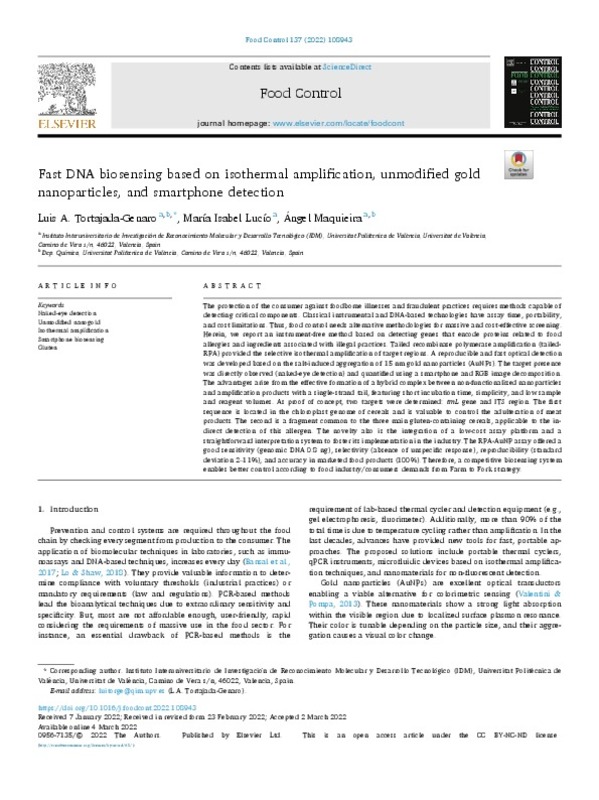JavaScript is disabled for your browser. Some features of this site may not work without it.
Buscar en RiuNet
Listar
Mi cuenta
Estadísticas
Ayuda RiuNet
Admin. UPV
Fast DNA biosensing based on isothermal amplification, unmodified gold nanoparticles, and smartphone detection
Mostrar el registro sencillo del ítem
Ficheros en el ítem
| dc.contributor.author | Tortajada-Genaro, Luis Antonio
|
es_ES |
| dc.contributor.author | Lucío, María Isabel
|
es_ES |
| dc.contributor.author | Maquieira Catala, Angel
|
es_ES |
| dc.date.accessioned | 2022-04-27T06:27:57Z | |
| dc.date.available | 2022-04-27T06:27:57Z | |
| dc.date.issued | 2022-07 | es_ES |
| dc.identifier.issn | 0956-7135 | es_ES |
| dc.identifier.uri | http://hdl.handle.net/10251/182133 | |
| dc.description.abstract | [EN] The protection of the consumer against foodborne illnesses and fraudulent practices requires methods capable of detecting critical components. Classical instrumental and DNA-based technologies have assay time, portability, and cost limitations. Thus, food control needs alternative methodologies for massive and cost-effective screening. Herein, we report an instrument-free method based on detecting genes that encode proteins related to food allergies and ingredients associated with illegal practices. Tailed recombinase polymerase amplification (tailed-RPA) provided the selective isothermal amplification of target regions. A reproducible and fast optical detection was developed based on the salt-induced aggregation of 15 nm gold nanoparticles (AuNPs). The target presence was directly observed (naked-eye detection) and quantified using a smartphone and RGB image decomposition. The advantages arise from the effective formation of a hybrid complex between non-functionalized nanoparticles and amplification products with a single-strand tail, featuring short incubation time, simplicity, and low sample and reagent volumes. As proof of concept, two targets were determined: trnL gene and ITS region. The first sequence is located in the chloroplast genome of cereals and is valuable to control the adulteration of meat products. The second is a fragment common to the three main gluten-containing cereals, applicable to the indirect detection of this allergen. The novelty also is the integration of a low-cost assay platform and a straightforward interpretation system to foster its implementation in the industry. The RPA-AuNP assay offered a good sensitivity (genomic DNA 0.8 ng), selectivity (absence of unspecific response), reproducibility (standard deviation 2¿11%), and accuracy in marketed food products (100%). Therefore, a competitive biosensing system enables better control according to food industry/consumers demands from Farm to Fork strategy. | es_ES |
| dc.description.sponsorship | MINECO Project PID2019-110713RB-I00 and Generalitat Valenciana PROMETEO/2020/094. Students that have supported us during the research. | es_ES |
| dc.language | Inglés | es_ES |
| dc.publisher | Elsevier | es_ES |
| dc.relation.ispartof | Food Control | es_ES |
| dc.rights | Reconocimiento - No comercial - Sin obra derivada (by-nc-nd) | es_ES |
| dc.subject | Naked-eye detection | es_ES |
| dc.subject | Unmodified nanogold | es_ES |
| dc.subject | Isothermal amplification | es_ES |
| dc.subject | Smartphone biosensing | es_ES |
| dc.subject | Gluten | es_ES |
| dc.subject.classification | QUIMICA ANALITICA | es_ES |
| dc.title | Fast DNA biosensing based on isothermal amplification, unmodified gold nanoparticles, and smartphone detection | es_ES |
| dc.type | Artículo | es_ES |
| dc.identifier.doi | 10.1016/j.foodcont.2022.108943 | es_ES |
| dc.relation.projectID | info:eu-repo/grantAgreement/AEI/Plan Estatal de Investigación Científica y Técnica y de Innovación 2017-2020/PID2019-110713RB-I00/ES/HACIA EL BIOSENSADO HOLOGRAFICO AVANZADO/ | es_ES |
| dc.relation.projectID | info:eu-repo/grantAgreement/GENERALITAT VALENCIANA//PROMETEO%2F2020%2F094//HOLOGRAFÍA. UNA VIA PARA AFRONTAR NUEVOS RETOS EN BIOSENSADO/ | es_ES |
| dc.rights.accessRights | Abierto | es_ES |
| dc.contributor.affiliation | Universitat Politècnica de València. Departamento de Química - Departament de Química | es_ES |
| dc.description.bibliographicCitation | Tortajada-Genaro, LA.; Lucío, MI.; Maquieira Catala, A. (2022). Fast DNA biosensing based on isothermal amplification, unmodified gold nanoparticles, and smartphone detection. Food Control. 137:1-10. https://doi.org/10.1016/j.foodcont.2022.108943 | es_ES |
| dc.description.accrualMethod | S | es_ES |
| dc.relation.publisherversion | https://doi.org/10.1016/j.foodcont.2022.108943 | es_ES |
| dc.description.upvformatpinicio | 1 | es_ES |
| dc.description.upvformatpfin | 10 | es_ES |
| dc.type.version | info:eu-repo/semantics/publishedVersion | es_ES |
| dc.description.volume | 137 | es_ES |
| dc.relation.pasarela | S\458665 | es_ES |
| dc.contributor.funder | GENERALITAT VALENCIANA | es_ES |
| dc.contributor.funder | AGENCIA ESTATAL DE INVESTIGACION | es_ES |
| dc.contributor.funder | Universitat Politècnica de València | |
| dc.subject.ods | 02.- Poner fin al hambre, conseguir la seguridad alimentaria y una mejor nutrición, y promover la agricultura sostenible | es_ES |
| dc.subject.ods | 03.- Garantizar una vida saludable y promover el bienestar para todos y todas en todas las edades | es_ES |








